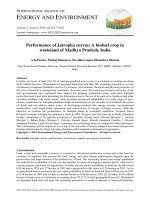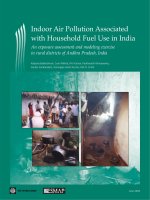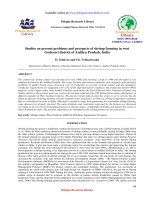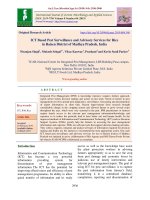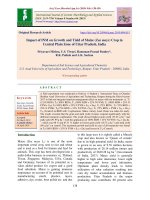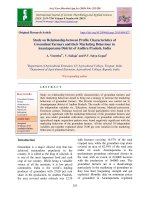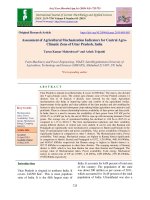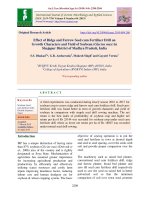Screening of micro flora found in soil samples surrounding the paper mill in north-western region of Uttar Pradesh, India
Bạn đang xem bản rút gọn của tài liệu. Xem và tải ngay bản đầy đủ của tài liệu tại đây (376.68 KB, 6 trang )
Int.J.Curr.Microbiol.App.Sci (2019) 8(3): 1633-1638
International Journal of Current Microbiology and Applied Sciences
ISSN: 2319-7706 Volume 8 Number 03 (2019)
Journal homepage:
Original Research Article
/>
Screening of Micro Flora found in Soil Samples Surrounding the Paper Mill
in North-Western Region of Uttar Pradesh, India
Nisha Dhillon*, Shalu Choudhary, Surbhi Chaudhary,
Megha Singh, Sonam Arya and Lalit Kumar
Department of Biosciences, College of Applied Education and Health Sciences, Meerut, Uttar
Pradesh, India
*Corresponding author
ABSTRACT
Keywords
Bacteria,
Bioremediation,
Effluents,
Environmental
pollution, Soil
sample
Article Info
Accepted:
12 February 2019
Available Online:
10 March 2019
Pulp and paper industries are considered as one of the major polluters of the environment
all over the world. These industries are the fifth largest contributor to water pollution.
Pulping process, used for paper manufacturing leads to release of toxic chemicals or
effluents into the environment and pollute water, air and soil therefore it is a major threat
to ecosystem. A number of microbes have been found in the nearby soil of paper mill that
are useful in the breakdown of environmental pollutants. Our approach was to demonstrate
the presence of bacteria that are useful in the process of bioremediation. The indigenous
bacterial species found in the soil sample nearby paper mill were Pseudomonas, Bacillus,
Klebsiella, Proteus, Alcaligenes and Streptococcus out of which Pseudomonas, Bacillus
and Alcaligenes have been found to be very useful in bioremediation process. Serial
dilution, sub-culture, staining and biochemical testing were performed for the
identification of bacterial species.
Introduction
Industrialization and globalization has lead to
exploitation and pollution of natural resources
for decades. World demand for paper has
grown rapidly and was around 5-6% per year.
The paper mills have a larger investment and
provide employment to 2 lakh people. It is
estimated that the capacity of the mills
increased from 8.3 million tonnes in 2010 to
14 million tonnes in 2020. In India, 70%
production of paper is from hardwood and
bamboo fiber, agro-waste and remaining 30%
is from recycled material (Jeenathunisa et al.,
2017). The paper industry is the largest
industry in India which is disturbing the
ecological balance of the environment by
discharging a wide variety of waste water in
their surroundings (Singh, 2015).
Wastewater is generated at different levels of
paper manufacturing method which comprises
of two main processes- pulping and
bleaching. In the pulping process, paper pulp
1633
Int.J.Curr.Microbiol.App.Sci (2019) 8(3): 1633-1638
is manufactured from the cellulose fibers
contained in wood. The effluent formed at
this stage contains lignin, hemicellulose,
resins, acids, phenols, etc. which impart dark
brown color to wastewater. Effluents from
bleaching process contain chlorinated organic
compounds, and Inorganic compounds
include heavy metals like manganese, lead,
cadmium, chromium, iron, copper, mercury,
etc. and gases such as nitrogen oxide,
phosphorus oxide, hydrogen sulphide, etc.
These compounds act as major sources of
pollution not just because they are toxic above
a relatively low concentration but also
because they are persistent remaining in the
environment for long even after the removal
of source of contamination. Number of
microorganisms including bacteria, fungi and
actinomycetes has been implicated to degrade
the xenobiotic compounds present in pulp and
paper mill effluent. (Hossain and Ismail,
2015).
In the entire paper pulp plant, bleaching
process discharges the highest amount of
pollutants into the water streams and nearby
soil surroundings. Various studies have
claimed the detrimental effects of the
effluents coming out of pulp and paper mills
on living organisms, water bodies and soil
receiving these pollutants.
A study in 1996 reported health impacts such
as diarrhea, vomiting, headaches, nausea and
eye irritation on children and workers due to
the pulp and paper mill wastewater
discharged to environment (Singh, 2011).
These effluents are also found to exhibit
mutagenic effect and adversely affecting
biodiversity.
The wastewater generated in bleaching
process has a high concentration of sodium
and a high sodium adsorption ratio which
leads to increased sodium content in the soil,
thus degrading the soil’s quality. The disposal
of paper mill effluent showed significant
(P<0.05) changes in soil characteristics. The
soil parameters namely: moisture content
(10.19%) and WHC (11.48%) were
decreased, while pH (2.75%), IC (126.08%),
Chlorine ion (46.35%), OE (38.70%), Sodium
ion (66.44%), Potassium ion (24.03%),
Calcium ion (72.16%), Magnesium ion
(144.97%), TKN (66.73%), Phosphate ion
(238.83%), Sulphate ion (23.78%), Cadmium
(1451.47%), Chromium (2082.85%), Copper
(115.47%), Iron (107.81%), Lead (496.5%)
and Zinc (138.68%) of the soil were increased
after disposal of paper mill effluent in
comparison to control soil (Kumar et al.,
2015).
Among different heavy metals discharged
from paper mill, chromium showed maximum
contamination and iron showed minimum
contamination (Kumar et al., 2015). These
studies show that paper mill effluents
significantly affect characteristics or nature of
soil in the vicinity of effluent discharge.
Therefore, it is obligatory to treat the effluents
before their discharge into environment.
Several methods have been employed to
remove color from pulp and paper mill
effluents. These can be categorized into
chemical, physical and biological methods.
Chlorinated phenolic compounds and
adsorbable organic halides (AOX) can be
efficiently reduced by adsorption, ozonation
and membrane filtration techniques (Pokhrel
and Viraraghavan, 2004) in almost all pulp
and paper industry full scale applications,
anaerobic treatment is followed by aerobic
post treatment. The suitability and the cost of
the anaerobic-aerobic and aerobic treatment
systems are largely affected by a variety of
mill specific factor (Rintala et al., 1994).
The biological colour removal process uses
several classes of microorganisms-bacteria,
algae and fungi to degrade the polymeric
1634
Int.J.Curr.Microbiol.App.Sci (2019) 8(3): 1633-1638
lignin derived chromophoric material
(Sharma et al., 2014). Other materials are
degraded slowly, accumulate in the
environment and occasionally exhibit toxicity
(Singh, 2011). Thus, our objective was to
isolate and identify indigenous bacterial
species found in soil near paper mill area that
could help efficiently and economically in the
treatment of paper mill effluents.
were prepared and stained according to the
Gram’s staining procedure to differentiate
between Gram+ve and Gram-ve bacteria
(Gram. 1884). Shapes were also examined.
The differences in staining responses to the
Gram stain can be related to chemical and
physical differences in their cell walls. The
morphology was also examined on NAM. The
colonies occur in different sizes and shape
like circular, irregular, rhizoid or filamentous.
Materials and Methods
Various materials and types of media were
employed. The glass wares used were
Erlenmeyer flasks (250ml and 500ml),
beakers, Petri dishes, glass rods, test tubes,
glass slides and dropper. The media that were
used included nutrient agar media (NAM),
Mac Conkey agar media, Blood agar media,
Simmon’s citrate agar media and Urea agar
media. The broth included tryptone broth,
MR-VP broth, and Hugh and Leifson’s OF
basal media. Different equipments were used
like autoclave, bunsen burner, laminar air
flow (LAF) cabinet, inoculating loop,
micropipettes, test tube stand, etc.
The soil sample was collected from vicinity of
paper mill from north-western region of Uttar
Pradesh. The samples were collected in 500
ml capacity sterile BOD Bottles. The
collected samples were brought to the
laboratory and analyzed for various isolation
of microflora and its physico-chemical. The
sample was taken from a few centimeters
deep and then serially diluted in laboratory.
NAM plates were prepared and sample was
spread on them. Overnight incubation was
given at 37oC.
Sub-culture: The different colonies obtained
from the overnight culture were streaked onto
NAM plates for the isolation of pure bacterial
colonies. Incubation was given at 37oC.
Morphological characterization: Morphology
was identified by Gram’s staining. Smears
Biochemical
characterization:
Various
biochemical tests were performed to identify
different species of bacteria. These tests are as
follows: indole test, methyl red test, VogesProskaeur test, oxidase test, catalase test,
urease test, oxidative fermentation test, etc.
Various confirmatory media were also
prepared and streaked with bacteria to
identify whether they are hemolytic or nonhemolytic and lactose fermenter. For testing
hemolysis, blood agar was used and for
testing lactose fermentation, MacConkey agar
was used.
Results and Discussion
Isolation of bacterial colonies was done on
NAM media. After overnight incubation of
dilution plates 10-4, 10-5, 10-6 and 10-7, the
following bacterial colonies were observed as
shown in figure 1.
On sub-culturing, pure bacterial colonies were
isolated which were differentiated on the
basis of pigmentation and morphological
characteristics. Colonies of different colors
(creamy, white, transparent and green),
shapes (rhizoid, irregular edges) and size were
seen as shown in figure 2.
After sub-culturing, biochemical analysis of
the pure bacterial colonies was done. Various
biochemical tests were performed and
differential media employed to determine the
1635
Int.J.Curr.Microbiol.App.Sci (2019) 8(3): 1633-1638
kind of species. Mannitol Salt Agar (MSA)
media was prepared and colonies were
cultured but only Streptococcus showed
minimal growth; MacConkey Agar media was
prepared to check the presence of gram
negative and lactose fermenting species, on
which Pseudomonas, Klebsiella, Alcaligenes
and Bacillus showed growth; Bacillus and
Streptococcus showed pink coloured colonies
which means they are capable of fermenting
lactose, Pseudomonas and Klebsiella showed
growth on Blood Agar media but these were
non-hemolytic in nature whereas Bacillus was
found to be hemolytic in nature.
Proteus shows positive result in Indole
production, MR reaction, VP reaction, Urease
activity and catalase activity. Streptococcus
shows positive result in Gram Staining,
Lactose Fermentation and Indole Production.
Klebsiella shows positive result in Citrate
activity, Urease activity and Catalase activity.
Bacillus mycoides shows positive result in
Gram Staining, Lactose Fermentation, VP
reaction, Urease activity and Catalase activity.
Pseudomonas putida shows positive result in
Citrate activity, Urease activity, Catalase
activity and Oxidase activity. Pseudomonas
aeruginosa shows positive result in Citrate
activity, Catalase activity and Oxidase
activity. Alcaligenes shows positive result in
Catalase activity and Oxidase activity. Table
1 shows that Proteus and Bacillus mycoides
gives maximum positive result while
performing biochemical analysis.
The biochemical tests performed included
IMViC test, oxidase test, catalase test and
urease activity test, the results of which are
given in the table 1.
Proteus
Streptococcus
Klebsiella
Bacillus
mycoides
Pseudomonas
putida
Pseudomonas
aeruginosa
Alcaligenes
Oxidase activity
Catalase activity
Urease activity
Citrate activity
VP reaction
MR reaction
Indole production
Lactose
fermentation
Gram stain
Species
Table.1 Biochemical analysis of bacterial colony obtained from soil nearby paper mill industry
in Northern Region
+
+
+
+
+
+
-
+
-
+
+
+
-
+
+
+
+
+
+
-
-
-
-
-
-
+
+
+
+
-
-
-
-
-
+
-
+
+
-
-
-
-
-
-
-
+
+
1636
Int.J.Curr.Microbiol.App.Sci (2019) 8(3): 1633-1638
Fig.1 Bacterial colonies as observed after serial dilution of soil sample and overnight incubation
Fig.2 Colonies observed after sub-culturing of overnight incubated plates
.
1637
Int.J.Curr.Microbiol.App.Sci (2019) 8(3): 1633-1638
Based on the results of the above conducted
experiment it can be inferred that bacterial
species such as Proteus and Bacillus
mycoides show maximum prevalence near
paper mill industry. This shows that are
capable of biodegradation of paper mill waste
are present near the site of pulp and paper mill
indigenously. Further research could be done
to study the ability of micro organisms which
are likely to provide economically
biodegradable processes for treating waste
from paper industries. These species could be
efficiently utilized in the transformation of
harmful paper mill waste into compounds that
are no longer harmful or less detrimental to
living organisms and their surrounding
environment.
Acknowledgment
We are highly thankful to College of Applied
Education and Health Sciences for providing
the laboratory facilities for doing our work.
References
Chupal, Y., Kumar, V. and Thakur, I. S. 2005.
Biodegradation and decolourization of pulp
and paper mill effluent by anaerobic and
aerobic microorganisms in a sequential
bioreactor. Wor Jour of Micr an Biot. Vol
(21). 1439.
Ghoreishi S.M. and Haghighi M.R., 2007.
Chromophores Removal in Pulp and Paper
Mill Effluent via Hydrogenation-Biological
Batch Reactors. Chem Engi Jour Vol127.61.
Hossain K and Ismail N, 2015. Bioremediation
and Detoxification of Pulp and Paper Mill
Effluent. Rese jour of EnviToxi, Vol9.113.
Jeenathunisa. N, Jeyabharathi. S and Arthi. J,
2017.Bioremediation of Paper and Pulp
Industrial Effluent Using Bacterial Isolates.
Inte Jou for Rese in App Sci & Engi Tech.
Vol 5.692.
Kumar V, Singh J, Kumar S ,Chopra A.K and
Thakur R.K, 2015. Effects of pulp and
paper mill effluent disposal on soil
characteristics in the vicinity of Uttaranchal
pulp
and
paper
mill,
Haridwar
(Uttarakhand), India. Inte Jour of Agri Sci
Rese Vol.4.117.
Maheshwari R, Rani B, Saxena A, Prasad M and
Singh U , 2012. Analysis of effluents from
recycled paper Industry. Jour of adv sci res.
3(1).82.
Murugesan K, 2003. Bioremediation of paper and
pulp mill effluents. Ind Jour of Exp Bio
(41).1243.
Pokhrel, D. and Viraraghavan T, 2004. Treatment
of pulp and paper mill wastewater. Sci of
the tot envi. Vol (333).37.
Rintala, J. A. and Puhakka. 1994. Anaerobic
treatment in pulp and paper mill waste
management. Bio Tech Vol (47).1.
Singh, A. 2011. Microbial degradation studies in
pulp and paper industries. Jour of Jay Vid
Wom Uni.4(6).
Singh, S. 2015. Study of waste water effluent
characteristics generated from paper
industries. Jour of Bas and Appl Engg Rese
Vol 2.1505.
volume 9 (3).
www.suezwaterhandbook.com
Sharma, R., Chandra, S., Singh, A. and Singh, K.
2014. Degradation of pulp and paper mill
effluents. IIOAB Jour 5(3): 6-12.
How to cite this article:
Nisha Dhillon, Shalu Choudhary, Surbhi Chaudhary, Megha Singh, Sonam Arya and Lalit
Kumar 2019. Screening of Micro Flora found in Soil Samples Surrounding the Paper Mill in
North-Western Region of Uttar Pradesh, India. Int.J.Curr.Microbiol.App.Sci. 8(03): 1633-1638.
doi: />
1638
